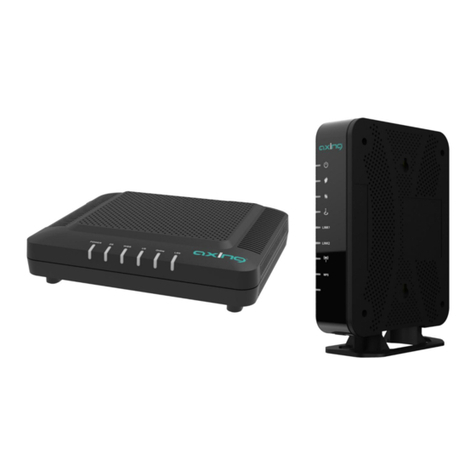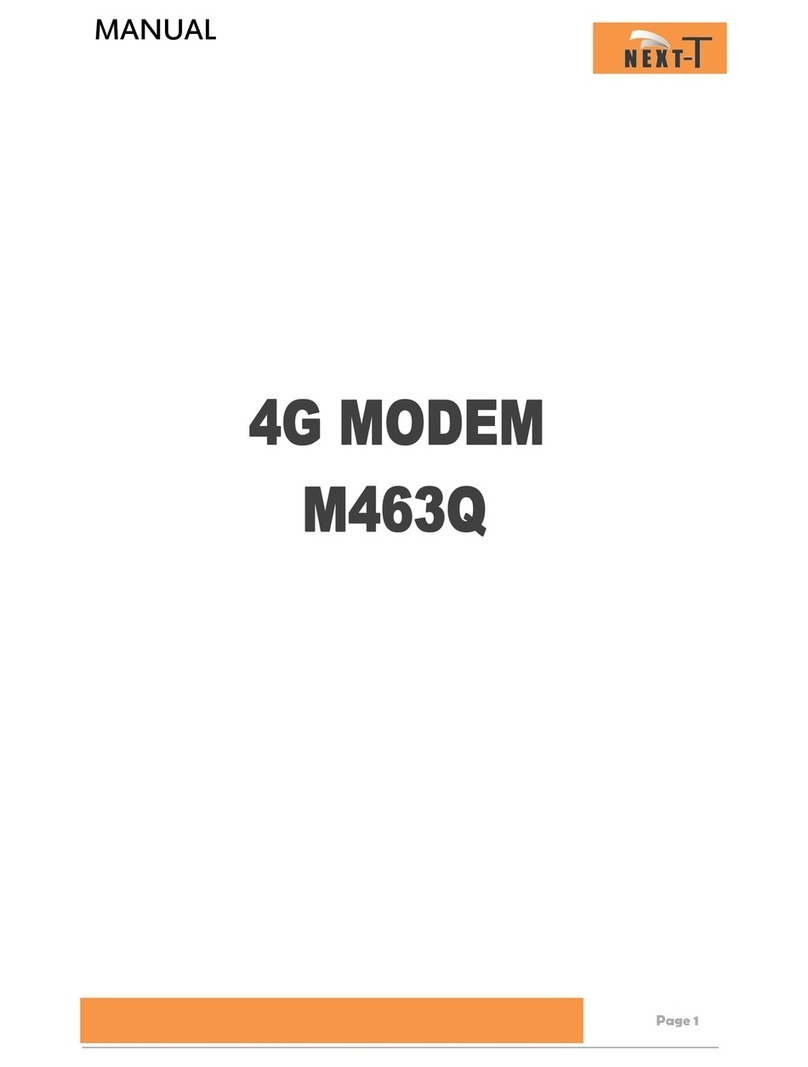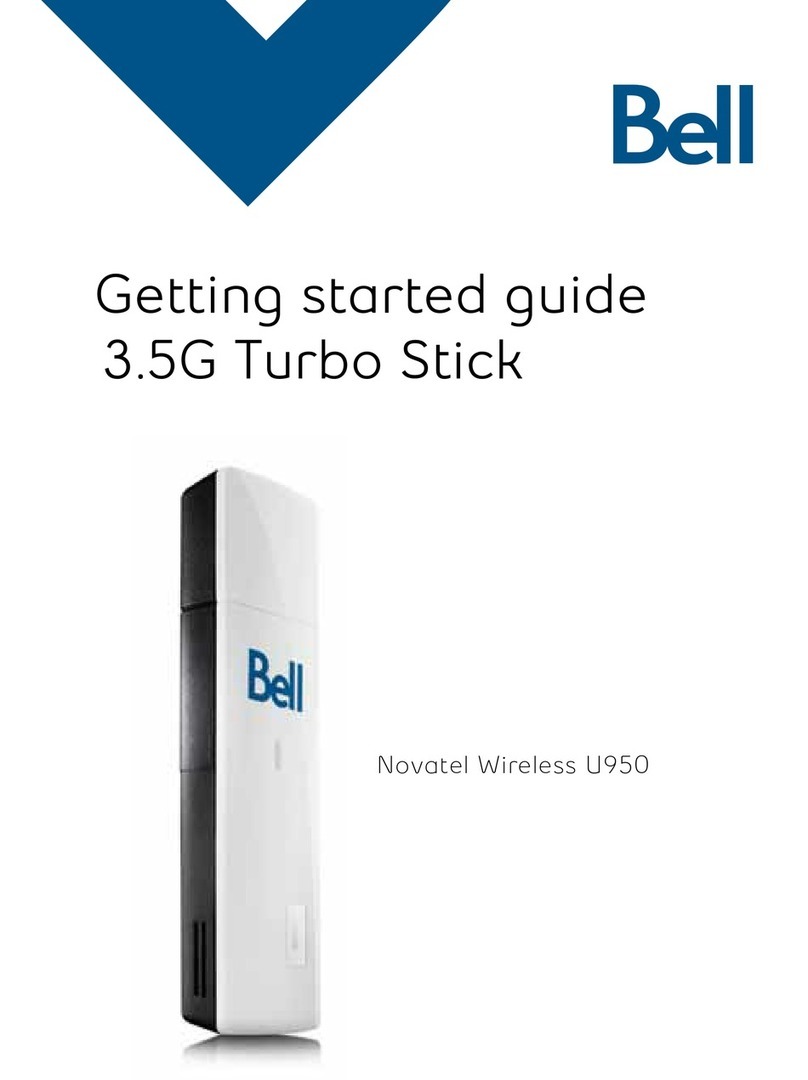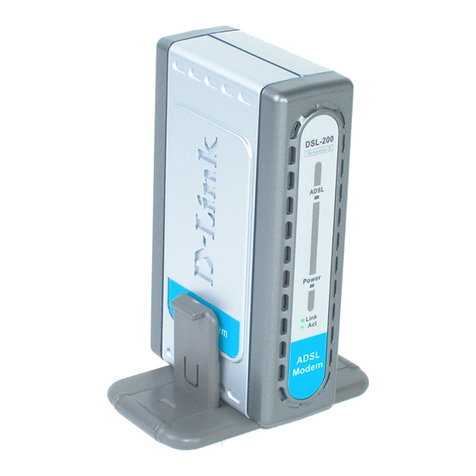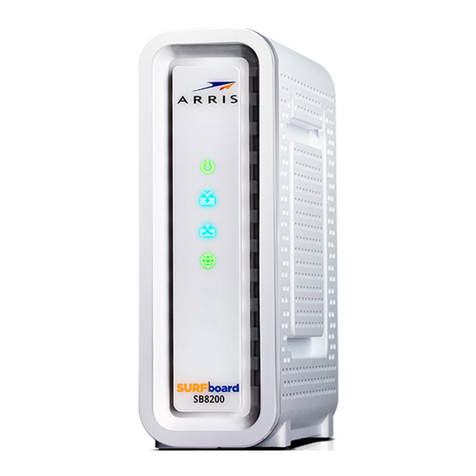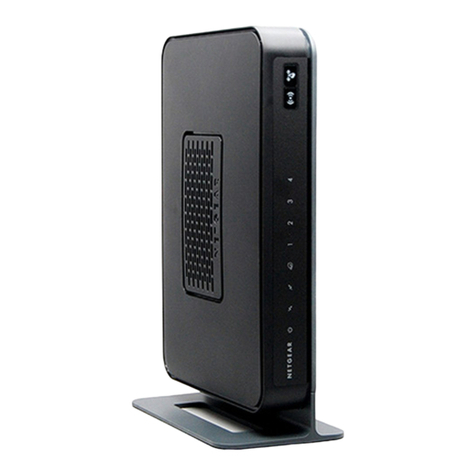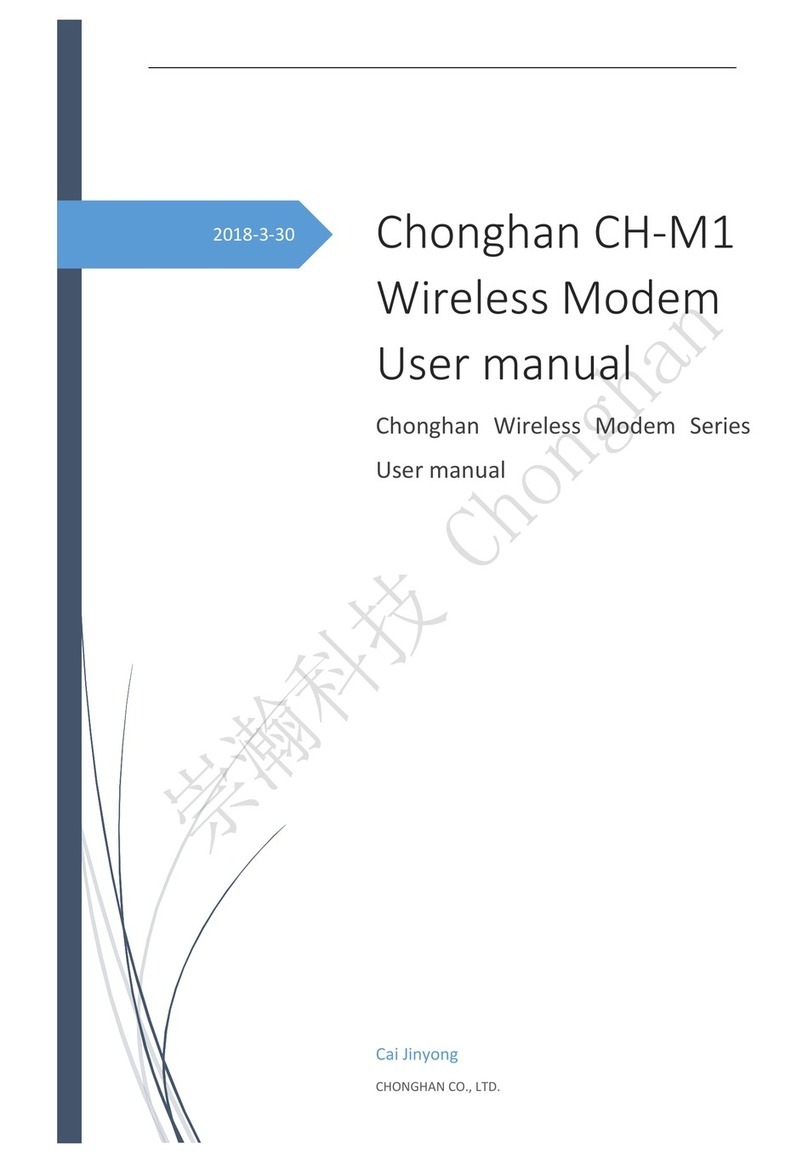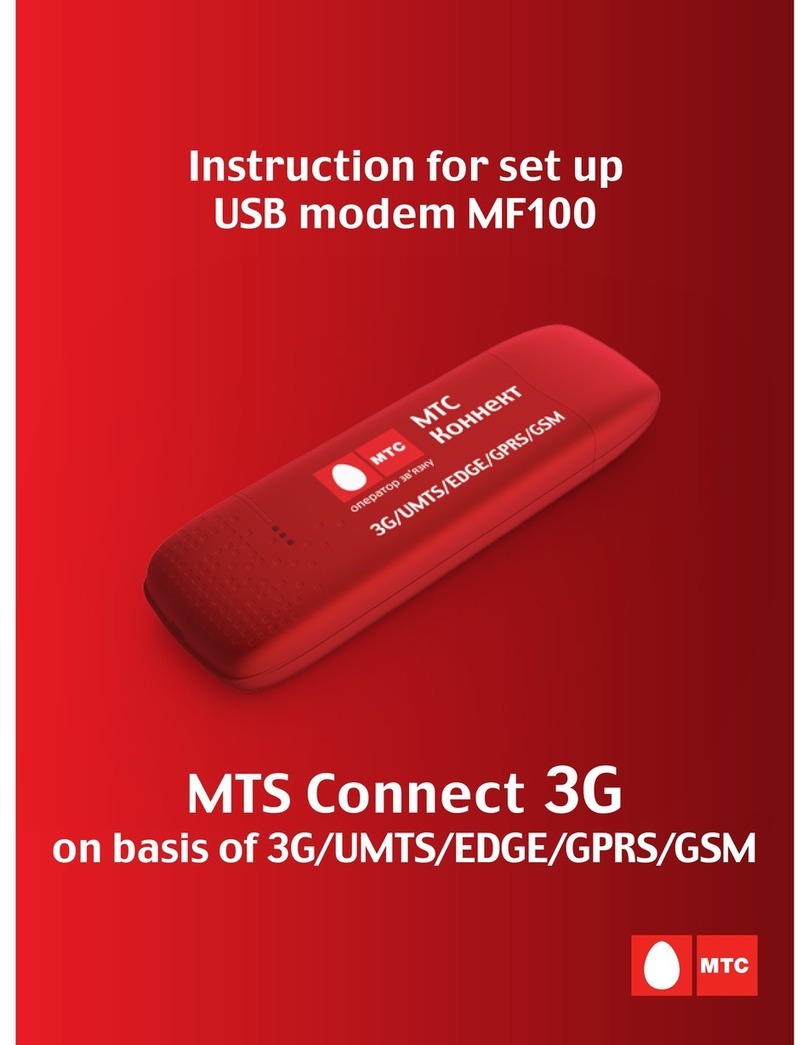Traverse Pulsar User manual

1
Pulsar
PulsarPulsar
Pulsar
ADSL PCI MODEM
User Manual – Linux
Revision 1.5

2
CHAPTER 1: INTRODUCTION....................................................................................................... 4
CHAPTER 2: HARDWARE INSTALLATION................................................................................... 5
2.1 Connections, switches and LEDs........................................................................................... 5
2.2 Installation .............................................................................................................................. 6
2.3 Filter Connections................................................................................................................... 7
3. Bridged Ethernet Setup (RFC 1483)............................................................................................8
3.1 Install Driver............................................................................................................................ 8
3.2 Load Driver............................................................................................................................. 8
3.3 IP Addressing and Interface Up..............................................................................................9
4. PPPoE Setup (RFC 1483) ......................................................................................................... 10
4.1 Install Driver.......................................................................................................................... 10
4.2 Load Driver........................................................................................................................... 10
4.3 Install PPPoE........................................................................................................................ 11
4.4 Configure PPPoE ................................................................................................................. 11
4.5 Interface Up.......................................................................................................................... 12
4.6 PPPoE Connect.................................................................................................................... 12
5. PPPoA Setup (RFC 2364) ......................................................................................................... 13
5.1 Install Driver.......................................................................................................................... 13
5.2 Create devices...................................................................................................................... 13
5.3 Load Driver........................................................................................................................... 14
5.4 PPP Passwords.................................................................................................................... 14
5.5 PPPoA Dialup Profile............................................................................................................ 15
5.6 PPPoA Connect.................................................................................................................... 15
APPENDIX A – ISP Atm Parameters (Vpi / Vci)............................................................................ 16
APPENDIX B – Troubleshooting....................................................................................................17
B.1 Loading Modules.................................................................................................................. 17
B.2 Line Sync.............................................................................................................................. 18
B.3 TX and RX packets.............................................................................................................. 18
B.4 LCP timeouts (PPPoE and PPPoA only)..............................................................................18
B.5 Authentication Failure (PPPoE and PPPoA only) ................................................................18
APPENDIX C – ATM Encapsulation options..................................................................................19
APPENDIX D – Technical Support and Warranty.......................................................................... 20
D.1 Technical Support................................................................................................................ 20
D.2 Returning a Product............................................................................................................. 20
D.3 Warranty Terms you should know....................................................................................... 21
D.4 Limited Warranty.................................................................................................................. 21
D.5 Copyright.............................................................................................................................. 22

3
WARNING : This product may only be connected to the Telecommunications Network
under the following conditions :
(i) The ADSL modem card can only be installed in a Computer that has a case (cover) fitted that
can only be removed with the use of a tool or key. The card should not be installed in a Computer
with a “Flip Top” case.
(ii) Do not connect the ADSL modem card to the Telecommunications Network until the Computer
case is fitted and screwed or locked in place.
(iii) In the event that the Computer case is to be removed, the ADSL Modem card must be
disconnected from the Telecommunications Network before the case is removed, and must not
be re-connected until the case is replaced and screwed or locked in place.

4
CHAPTER 1: INTRODUCTION
Features
•PCI PLUG and PLAY. No jumpers or switches.
•Supports BT, Telstra, Nextep and RequestDSL ADSL Lines
•Downstream data rates upto 8Mbps
•Upstream data rates upto 1Mbps
•Supports Bridged Ethernet, PPPoE and PPPoA protocols
•Linux Kernel 2.2 and 2.4 drivers
Packing List
You should find the following items in your Pulsar ADSL modem kit:
•Pulsar PCI ADSL modem card
•Distribution CD, including drivers and documentation files
•A 2 metre RJ-11 phone cable
Please contact your dealer if any items are damaged or missing.
Trademarks
Pulsar ADSL is a registered trademark of Traverse Technologies Australia Pty Ltd. All other
trademarks and copyrights are the property of their respective holders.
Introduction
This manual provides step-by-step instructions for installing and setting up the Pulsar ADSL
modem to connect to the Internet. Once installed your ASDL modem will give you high speed
access to the internet, and this connection can also be shared to allow other users on your
network to share the same internet connection.
ADSL provides fast, reliable internet connectivity that is always on, so you don’t need to dial up.
You can remain connected 24 hours a day and still use your phone line as you normally would.

5
CHAPTER 2: HARDWARE INSTALLATION
TX LED
This indicates transmit data activity
RX LED
This indicates receive data activity
LINK LED
This indicates that the Modem has finished training and achieved line synchronisation. During
training this LED will flash.
STATUS LED
This indicates that the Modem has DC power and the driver is correctly loaded.
ADSL Port
Connect this port to your ADSL line
2.1 Connections, switches and LEDs

6
(i) Power OFF your computer system.
(ii) Remove screws and case.
(iii) Locate a free PCI slot.
(iv) Unscrew/remove slot rear panel.
(v) Place the ADSL Modem card over the PCI slot. Press the Modem card down firmly with both
hands into the slot. Check to be sure that the Modem card is seated property in the PCI slot.
(vi) Screw/secure rear panel of ADSL Modem card.
(vii) Refit case and screws.
(viii) Plug one end of the RJ11 cable that came with your ADSL modem into the socket on the
modem and plug the other end into your ADSL line socket.
2.2 Installation

7
If your ADSL connection is also used by POTS (Plain Old Telephone System) devices such as
phones, fax machines and answering machines, they must be filtered to prevent them from
interfering with your ADSL connection.
The diagram below shows how POTS filters can be connected
It is also possible for several POTS devices to share the same filter
Important : DO NOT place a POTS filter in line between your ADSL modem and the Phone /
ADSL line.
2.3 Filter Connections

8
3. Bridged Ethernet Setup (RFC 1483)
(i) Firstly load the driver from your Pulsar distribution CD or from the Traverse website. The linux
drivers are located under the /linux subdirectory on the CD. There are several subdirectories for a
range of Linux kernels. For example the subdirectory
/linux/drivers/3.2.1/redhat7.3
Contains the RedHat 7.3 driver tarball called pulsar.tgz for version 3.2.1 of the driver. Copy this
onto your hard drive.
Alternatively you can compile a driver for any 2.4 kernel by using the driver engine at...
http://adsl4linux.no-ip.org
(ii) Untar the module from the tarball
tar -xvzf pulsar.tgz
(iii) move the driver to /lib/modules
mv pulsar.o /lib/modules
Load the module with the appropriate Vpi / Vci values
insmod /lib/modules/pulsar.o Rfc1483Mode=0 Rfc1483Vpi=8 Rfc1483Vci=35 GtiTrellis=0
Important : for a list of Vpi/Vci values for different providers (ISPs) refer to Appendix A
Hint : if you can’t find a driver for your kernel, try the following …
(a) Use the closest match and add the –f option when loading the module (2.2 kernels only)…
insmod –f /lib/modules/pulsar.o Rfc1483Mode=0 Rfc1483Vpi=8 Rfc1483Vci=35 GtiTrellis=0
(b) Use the Driver Engine at http://adsl4linux.no-ip.org to compile a driver for your kernel (2.4
kernels only)
Once the driver has been loaded, line sync should be obtained within about 30 seconds. The Line
Sync LED on the rear panel indicates the current state of the line.
3.1 Install Driver
3.2 Load Driver

9
(i) When your ADSL line is provisioned your ISP should provide you with an IP address (normally
public) and a gateway address. Once your driver is loaded you can bring up the interface
ifconfig 203.22.33.44 eth1 up
The above example shows a Public IP address of 203.22.33.44
Note : The Pulsar will be eth1 if you already have an ethernet card installed. Otherwise it
will be eth0. You can double check this in /var/log/messages
Oct 7 12:17:51 firewall kernel: pulsar0: GSI ADSL, eth1, ttyG/cug, 00:0A:FA:02:80:14
IRQ:10 Address:0xE8800000
(ii) Now add a route to your ISPs gateway
router add default gw 203.22.33.1 eth1
The above example shows a gateway address of 203.22.33.1
You should now be able to ping the gateway address, and addresses by number on the internet
ping 198.182.196.56
(iii) Now configure your DNS settings. Add your ISPs DNS settings to the /etc/resolv.conf file
nameserver 203.22.5.2
nameserver 203.22.5.3
The above example shows a primary DNS of 203.22.5.2 and a secondary DNS of 203.22.5.3
You should now be able to ping addresses by name on the internet
ping www.linux.org
3.3 IP Addressing and Interface Up

10
4. PPPoE Setup (RFC 1483)
(i) Firstly load the driver from your Pulsar distribution CD or from the Traverse website. The linux
drivers are located under the /linux subdirectory on the CD. There are several subdirectories for a
range of Linux kernels. For example …
/linux/drivers/3.2.1/redhat7.3
Contains the RedHat 7.3 driver tarball called pulsar.tgz for version 3.2.1 of the driver. Copy this
onto your hard drive.
Alternatively you can compile a driver for any 2.4 kernel by using the driver engine at...
http://adsl4linux.no-ip.org
(ii) Untar the module from the tarball
tar -xvzf pulsar.tgz
(iii) move the driver to /lib/modules
mv pulsar.o /lib/modules
Load the module with the appropriate Vpi / Vci values
insmod /lib/modules/pulsar.o Rfc1483Mode=0 Rfc1483Vpi=8 Rfc1483Vci=35 GtiTrellis=0
Important : for a list of Vpi/Vci values for different providers (ISPs) refer to Appendix A
Hint : if you can’t find a driver for your kernel, try the following …
(a) Use the closest match and add the –f option when loading the module (2.2 kernels only)…
insmod –f /lib/modules/pulsar.o Rfc1483Mode=0 Rfc1483Vpi=8 Rfc1483Vci=35 GtiTrellis=0
(b) Use the Driver Engine at http://adsl4linux.no-ip.org to compile a driver for your kernel (2.4
kernels only)
Once the driver has been loaded, line sync should be obtained within about 30 seconds. The Line
Sync LED on the rear panel indicates the current state of the line.
4.1 Install Driver
4.2 Load Driver

11
There are two popular methods for running PPPoE under Linux
-Use the PPPoE support in the kernel
-Use the Roaring Penguin PPPoE client
Roaring Penguin is the easiest method so it is described here. However experienced users will
want to use the PPPoE support in the kernel. In this case refer to the Linux DSL howto at …
http://www.tldp.org/HOWTO/DSL-HOWTO/index.html
Important : Problems have been reported with Roaring Penguin V3.5-1 and Debian
Distributions. Debian users should use pppoeconf instead.
(i) Download Roaring Penguin PPPoE (RP-PPPoE)
Firstly download a copy of RP-PPPoE from
http://www.roaringpenguin.com/pppoe/#download
Important : Your distribution may already include RP-PPPoE, however if it is earlier than
V3.5-1 you should upgrade it
(ii) Install RP-PPPoE
rpm –i rp-pppoe-3.5-1.i386.rpm
If your distribution doesn’t support RPMs then perform a source install
tar xvfz rp-pppoe-3.5.tar.gz
cd rp-pppoe-3.5
./go
4.4 Configure PPPoE
Now run the RP-PPPoE configuration utility
adsl-setup
Answer all questions as prompted.
Note : The Pulsar will be eth1 if you already have an ethernet card installed. Otherwise it
will be eth0. You can double check this in /var/log/messages
Oct 7 12:17:51 firewall kernel: pulsar0: GSI ADSL, eth1, ttyG/cug, 00:0A:FA:02:80:14
IRQ:10 Address:0xE8800000
4.3 Install PPPoE

12
When your driver is loaded you can bring up the interface
ifconfig eth1 up
Now start RP-PPPoE
adsl-start
After a few seconds you should see the connected message. If this doesn’t occur, and RP-PPPoE
times out, refer to Appendix B Troubleshooting.
4.5 Interface Up
4.6 PPPoE Connect

13
5. PPPoA Setup (RFC 2364)
(i) Firstly load the driver from your Pulsar distribution CD or from the Traverse website. The linux
drivers are located under the /linux subdirectory on the CD. There are several subdirectories for a
range of Linux kernels. For example …
/linux/drivers/3.2.1/redhat7.3
Contains the RedHat 7.3 driver tarball called pulsar.tgz for version 3.2.1 of the driver. Copy this
onto your hard drive.
Alternatively you can compile a driver for any 2.4 kernel by using the driver engine at...
http://adsl4linux.no-ip.org
(ii) Untar the module from the tarball
tar -xvzf pulsar.tgz
(iii) move the driver to /lib/modules
mv pulsar.o /lib/modules
The Pulsar driver provides a tty interface for PPPoA. You need to create the following devices for
PPPoA
mknod /dev/ttyG0 c 43 0
chown root.nobody /dev/ttyG0
chmod 0660 /dev/ttyG0
mknod /dev/cug0 c 44 0
chown root.nobody /dev/cug0
chmod 0660 /dev/cug0
5.1 Install Driver
5.2 Create devices

14
Load the module with the appropriate Vpi / Vci values
insmod /lib/modules/pulsar.o Rfc2364Mode=0 Rfc2364Vpi=0 Rfc2364Vci=38 GtiTrellis=0
Important : for a list of Vpi/Vci values for different providers (ISPs) refer to Appendix A
Hint : if you can’t find a driver for your kernel, try the following …
(a) Use the closest match and add the –f option when loading the module (2.2 kernels only)…
insmod /lib/modules/pulsar.o Rfc2364Mode=0 Rfc2364Vpi=0 Rfc2364Vci=38 GtiTrellis=0
(b) Use the Driver Engine at http://adsl4linux.no-ip.org to compile a driver for your kernel (2.4
kernels only)
Once the driver has been loaded, line sync should be obtained within about 30 seconds. The Line
Sync LED on the rear panel indicates the current state of the line.
Passwords for ppp dialup connections are stored in the following files
/etc/ppp/chap-secrets
/etc/ppp/pap-secrets
If you are unsure which protocol your ISP requires, set up both files the same.
Shown below is an example of a secrets file…
# client server secret
fred * flintstone
This example shows the following user account:
Username: fred Password: flintstone
Note that the server entry should always be a wildcard “*”.
5.3 Load Driver
5.4 PPP Passwords

15
Next Create a ppp dialup profile. Create a file called /etc/ppp/peers/adsl containing the following
options
user "fred"
ttyG0
sync
persist
The following command invokes pppd using the adsl profile created above
pppd call adsl
Now run a tail on /var/log/messages and hopefully you will see something like the following
tail –f /var/log/messages
Oct 15 10:21:13 rh73 pppd[1442]: pppd 2.4.1 started by root, uid 0
Oct 15 10:21:13 rh73 pppd[1442]: Using interface ppp0
Oct 15 10:21:13 rh73 pppd[1442]: Connect: ppp0 <--> /dev/ttyG0
Oct 15 10:21:13 rh73 /etc/hotplug/net.agent: assuming ppp0 is already up
Oct 15 10:21:13 rh73 pppd[1442]: local IP address 192.168.1.2
Oct 15 10:21:13 rh73 pppd[1442]: remote IP address 192.168.1.1
5.5 PPPoA Dialup Profile
5.6 PPPoA Connect

16
APPENDIX A – ISP Atm Parameters (Vpi / Vci)
Country Provider ATM
Protocol VPI VCI
.au Telstra PPPoE
or Bridged Eth. 835
.au Nextep Bridged Eth. 1 32
Austria AON PPPoA 8 48
.be Belgacom PPPoE
or Bridged Eth. 835
.bh Batelco PPPoA 8 35
.ch Sunrise and
Bluewin PPPoE 8 35
.fr Wannadoo PPPoA or
PPPoE 835
.nl PPPoA 8 48
.nz NZ Telecom*** PPPoA 0 100
.pt Portugal Telecom PPPoE
or Bridged Eth. 035
.uk British Telecom PPPoA 0 38
USA ---- PPPoA 8 35
***NOTE : 0/100 is also the default LAN PVC so to use a WAN (PPPoA) PVC or 0/100 you must
move the LAN PVC elsewhere. eg.
insmod /lib/modules/pulsar.o Rfc2364Mode=0 Rfc2364Vpi=0 Rfc2364Vci=100 Rfc1483Vpi=1
GtiTrellis=0
This sets the LAN VPI to 1/100 and the WAN VPI to 0/100.

17
APPENDIX B – Troubleshooting
If the module loads without error messages, you should see the following in response to the
lsmod command…
Module Size Used by
pulsar 252410 0 (unused)
You will probably also see several other kernel modules loaded.
You should also see the following at the end of the /var/log/messages file…
Oct 7 12:17:51 firewall kernel: pulsar: Traverse Pulsar ADSL pulsar.o v3.1.2 1-Oct-2002
Oct 7 12:17:51 firewall kernel: pulsar: powered by GlobespanVirata ADSL Firmware
Version: S6118
Oct 7 12:17:51 firewall kernel: GpAdapterInit - StartRFC1483_MODE_BRIDGED_ETH_LLC
Oct 7 12:17:51 firewall kernel: pAdapter->AtmUniHandle c75ed000
Oct 7 12:17:51 firewall kernel: pAdapter c6332000
Oct 7 12:17:51 firewall kernel: pulsar0: GSI ADSL, eth1, ttyG/cug, 00:0A:FA:02:80:14
IRQ:10 Address:0xE8800000
If the driver fails to load, use the cat /proc/pci command to check to see if your ADSL card has
been detected by the bios. In amongst the other PCI devices on you machine you should see…
Bus 0, device 14, function 0:
Network controller: Unknown vendor Unknown device (rev 1).
Vendor id=14bc. Device id=d002.
Slow devsel. Fast back-to-back capable. IRQ 10. Master Capable. Latency=32. Min
Gnt=3.Max Lat=200.
Non-prefetchable 32 bit memory at 0xe8800000 [0xe8800000].
Note : the addresses, bus number and device number will vary from machine to machine.
If the ADSL card is not listed, then you should check to see that the card is seated correctly in it’s
PCI slot. You can also try another slot. Also check the edge connector on the card for signs of dirt,
pizza finger prints or contamination. The edge connector can be cleaned by using an abrasive
pencil eraser, then wipe it with a clean cloth dipped in Metholated Spirits.
B.1 Loading Modules

18
Once you have loaded the pulsar model, you should obtain line sync within about 30 seconds.
Once line sync has been obtained you will see this logged in /var/log/messages…
Oct 7 12:22:59 firewall kernel: pulsar0: Link established (512/128)
You should also see the Line Sync LED come on. If this doesn’t occur check the connection
between your ADSL modem and the line socket on the wall. Also try disconnecting all other device
such as phones, answering machines and fax machines from the line.
Hint : If you have other devices sharing your ADSL line they must be connected via a filter
or splitter to prevent them from interfering with your ADSL service.
If you are using Bridged Ethernet or PPPoE you can use the ifconfig command to check if
packets are being sent and received. If you so that packets are being sent, but none are received
check your ATM settings. Do you have the correct VPI and VCI for your provider? See Appendix
A.
Check /var/log/messages for LCP timeouts. These are often caused by incorrect ATM settings.
Check your VPI and VCI values against the table in Appendix A.
Check your username and password in the following files
/etc/ppp/chap-secrets
/etc/ppp/pap-secrets
Note : Some providers require an @provider in the username, eg.
mickey@bigpond
or
minnie@bt
B.2 Line Sync
B.3 TX and RX packets
B.4 LCP timeouts (PPPoE and PPPoA only)
B.5 Authentication Failure (PPPoE and PPPoA only)

19
APPENDIX C – ATM Encapsulation options
Other ATM encapsulation methods are also supported. The encapsulation method is configured
when the driver is loaded. For example
Rfc1483Mode=0 (Bridged Ethernet)
or
Rfc2364Mode=0 (PPPoA with VC Encapsulation)
A list of all modes is shown below...
RFC1483
RFC1483_MODE_BRIDGED_ETH_LLC = 0, (default)
RFC1483_MODE_BRIDGED_ETH_VC = 1,
RFC1483_MODE_ROUTED_IP_LLC = 2,
RFC1483_MODE_ROUTED_IP_VC = 3,
RFC1483_MODE_RFC1577_ENCAP = 4
RFC2364
RFC2364_MODE_VC = 0, (default)
RFC2364_MODE_LLC = 1

20
APPENDIX D – Technical Support and Warranty
D.1 Technical Support
If you encounter problems with your Pulsar ADSL Modem, and you cannot locate the problem,
firstly contact the dealer where you purchased your modem. If your dealer is unable to help you
then contact:
Traverse Technologies Australia Pty Ltd.
652 Smith St
Clifton Hill
Vic 3068
Internet: http://www.traverse.com.au
support@traverse.com.au
D.2 Returning a Product
If Technical Support determines that you need to return the product for warranty repair service,
you will be issued a Return Authorisation (RA) number.
Return Authorisation Guidelines:
1. No product will be accepted for return for warranty service unless accompanied by a valid RA
number. No RA number will be issued without a valid serial number. Write the RA number
clearly on the outside of the package as follows: “RA#Annnn”.
2. Keep a record of the RA number and the name of the service representative who issued you
the RA number for future reference.
3. Return a copy of the original sales invoice for proof of purchase and verification of warranty.
4. If it is determined that your warranty has expired or that the problem is not covered by the
warranty, a method of payment will have to be authorised before an RA number is issued.
5. Write your name, return address and RA number on a small strip of paper and tape it to the
ADSL Modem before packing it
6. Write a note describing the problem giving as much detail as possible.
7. Place the modem in the original packaging, then in padded shipping bag. Use protective
material, such as bubble wrap or foam to further protect the modem.
8. The RA number that is issued to you is valid for only thirty days after the date of issue.
9. We will not accept packages that are not prepaid for shipping charges. We will not accept
COD shipments for shipping costs.
Table of contents

